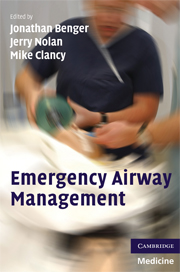Book contents
- Frontmatter
- Contents
- List of contributors
- Foreword
- List of abbreviations
- 1 Introduction and overview
- 2 Delivery of oxygen
- 3 Airway assessment
- 4 Basic airway management techniques
- 5 Indications for intubation
- 6 Preparation for rapid sequence induction and tracheal intubation
- 7 Rapid sequence induction and tracheal intubation
- 8 Pharmacology of emergency airway drugs
- 9 Difficult and failed airway
- 10 Post-intubation management and preparation for transfer
- 11 Emergency airway management in special circumstances
- 12 Non-invasive ventilatory support
- 13 The interface between departments and hospitals
- 14 Audit and skills maintenance
- Appendix: Emergency airway algorithms
- Index
- References
2 - Delivery of oxygen
Published online by Cambridge University Press: 22 August 2009
- Frontmatter
- Contents
- List of contributors
- Foreword
- List of abbreviations
- 1 Introduction and overview
- 2 Delivery of oxygen
- 3 Airway assessment
- 4 Basic airway management techniques
- 5 Indications for intubation
- 6 Preparation for rapid sequence induction and tracheal intubation
- 7 Rapid sequence induction and tracheal intubation
- 8 Pharmacology of emergency airway drugs
- 9 Difficult and failed airway
- 10 Post-intubation management and preparation for transfer
- 11 Emergency airway management in special circumstances
- 12 Non-invasive ventilatory support
- 13 The interface between departments and hospitals
- 14 Audit and skills maintenance
- Appendix: Emergency airway algorithms
- Index
- References
Summary
Objectives
The objectives of this chapter are to:
understand the causes of hypoxaemia
be familiar with devices available to increase the inspired oxygen concentration
understand the function and use of the self-inflating bag-mask
understand the function and use of the Mapleson C breathing system
understand how to monitor oxygenation
understand the principle of pre-oxygenation.
Causes of hypoxaemia
The strict definition of hypoxaemia is a partial pressure of oxygen in the arterial blood (PaO2) below normal; however, a value of <8kPa or 60mmHg (equivalent to an arterial oxygen saturation of approximately 90%) is often used to define hypoxaemia requiring treatment. In nearly all patients hypoxaemia can usually be improved, at least initially, by increasing the inspired oxygen concentration.
Although the cause of hypoxaemia is usually multifactorial, there are several distinct mechanisms:
alveolar hypoventilation
mismatch between ventilation and perfusion within the lungs
pulmonary diffusion defects
reduced inspired oxygen concentration.
Alveolar hypoventilation
Insufficient oxygen enters the alveoli to replace that taken up by the blood. Both the alveolar partial pressure of oxygen PaO2 and arterial partial pressure of oxygen (PaO2) decrease. In most patients, increasing the inspired oxygen concentration will restore alveolar and arterial PO2. When an adult's tidal volume decreases below approximately 150ml there is no ventilation of the alveoli, only the ‘dead space’, which is the volume of the airways that plays no part in gas exchange. No oxygen reaches the alveoli, irrespective of the inspired concentration, and profound hypoxaemia will follow. At this point ventilatory support and supplementary oxygen will be required.
- Type
- Chapter
- Information
- Emergency Airway Management , pp. 3 - 18Publisher: Cambridge University PressPrint publication year: 2008



